Astronomers Find Spark of Star Birth Across Billions of Years
Submitted by chandra on Wed, 2024-01-10 14:49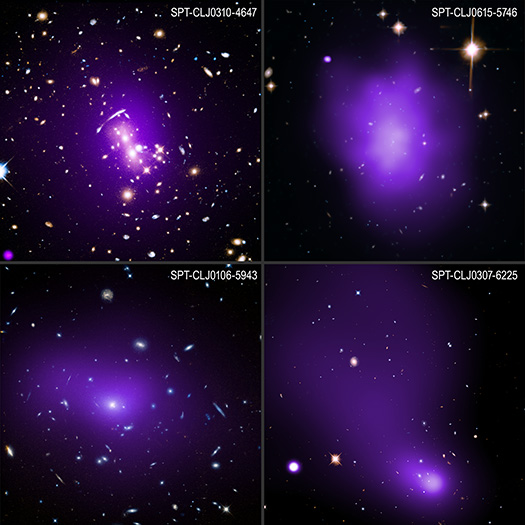
Brightest Cluster Galaxies Survey
Credit: X-ray: NASA/CXC/MIT/M. Calzadilla el al.; Optical: NASA/ESA/STScI;
Image Processing: NASA/CXC/SAO/N. Wolk & J. Major
These four images represent a sample of galaxy clusters that are part of the largest and most complete study to learn what triggers stars to form in the universe’s biggest galaxies, as described in our latest press release. This research, made using NASA’s Chandra X-ray Observatory and other telescopes, showed that the conditions for stellar conception in these exceptionally massive galaxies have not changed over the last ten billion years.
Galaxy clusters are the largest objects in the universe held together by gravity and contain huge amounts of hot gas seen in X-rays. This hot gas weighs several times the total mass of all the stars in all the hundreds of galaxies typically found in galaxy clusters. In the four galaxy cluster images in this graphic, X-rays from hot gas detected by Chandra are in purple and optical data from NASA’s Hubble Space Telescope, mostly showing galaxies in the clusters, are yellow and cyan.
NASA Telescopes Chase Down "Green Monster" in Star's Debris
Submitted by chandra on Mon, 2024-01-08 09:57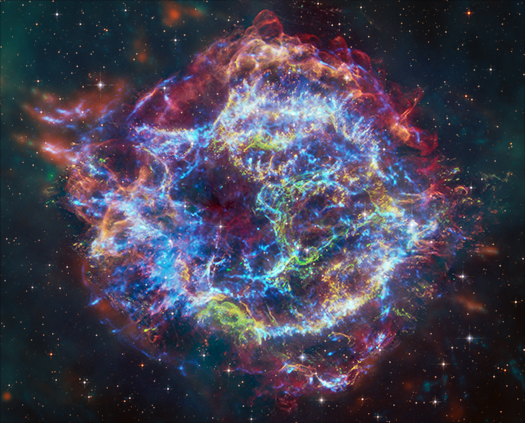
Cassiopeia A
Credit: X-ray: NASA/CXC/SAO; Optical: NASA/ESA/STScI; IR: NASA/ESA/CSA/STScI/Milisavljevic et al., NASA/JPL/CalTech; Image Processing: NASA/CXC/SAO/J. Schmidt and K. Arcand
For the first time astronomers have combined data from NASA’s Chandra X-ray Observatory and James Webb Space Telescope to study the well-known supernova remnant Cassiopeia A (Cas A). As described in our latest press release, this work has helped explain an unusual structure in the debris from the destroyed star called the “Green Monster”, first discovered in Webb data in April 2023. The research has also uncovered new details about the explosion that created Cas A about 340 years ago, from Earth’s perspective.
NASA Telescopes Start the Year With a Double Bang
Submitted by chandra on Tue, 2024-01-02 11:48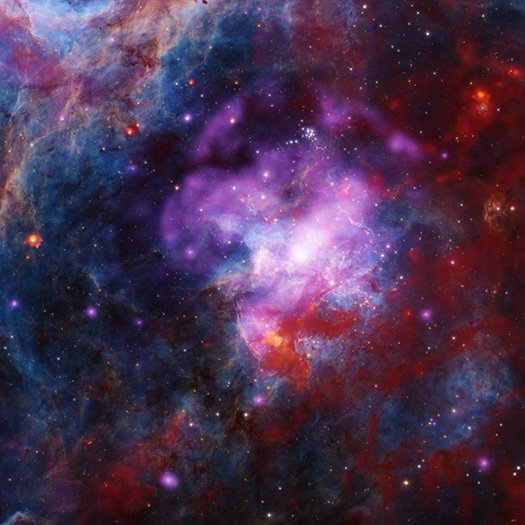
30 Doradus B
Credit: X-ray: NASA/CXC/Penn State Univ./L. Townsley et al.; Optical: NASA/STScI/HST; Infrared: NASA/JPL/CalTech/SST; Image Processing: NASA/CXC/SAO/J. Schmidt, N. Wolk, K. Arcand
A colorful, festive image shows different types of light containing the remains of not one, but at least two, exploded stars. This supernova remnant is known as 30 Doradus B (30 Dor B for short) and is part of a larger region of space where stars have been continuously forming for the past 8 to 10 million years. It is a complex landscape of dark clouds of gas, young stars, high-energy shocks, and superheated gas, located 160,000 light-years away from Earth in the Large Magellanic Cloud, a small satellite galaxy of the Milky Way.
The new image of 30 Dor B was made by combining X-ray data from NASA’s Chandra X-ray Observatory (purple), optical data from the Blanco 4-meter telescope in Chile (orange and cyan), and infrared data from NASA’s Spitzer Space Telescope (red). Optical data from NASA’s Hubble Space Telescope was also added in black and white to highlight sharp features in the image.
Sprightly Stars Illuminate 'Christmas Tree Cluster'
Submitted by chandra on Mon, 2023-12-18 10:09This new image of NGC 2264, also known as the “Christmas Tree Cluster,” shows the shape of a cosmic tree with the glow of stellar lights. NGC 2264 is, in fact, a cluster of young stars — with ages between about one and five million years old — in our Milky Way about 2,500 light-years away from Earth. The stars in NGC 2264 are both smaller and larger than the Sun, ranging from some with less than a tenth the mass of the Sun to others containing about seven solar masses.
NASA's Chandra Catches Spider Pulsars Destroying Nearby Stars
Submitted by chandra on Thu, 2023-11-30 09:56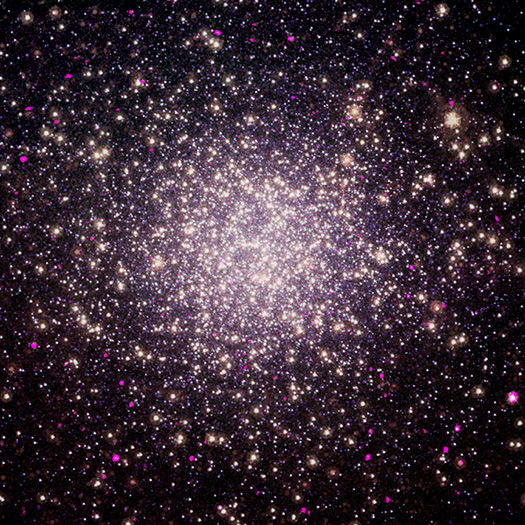
Omega Centauri
Credit: X-ray: NASA/CXC/San Francisco State Univ./A. Cool et al.; Optical: NASA/ESA/STScI; IR: NASA/JPL/Caltech; Image Processing: NASA/CXC/SAO/N. Wolk
A group of dead stars known as “spider pulsars” are obliterating companion stars within their reach. Data from NASA’s Chandra X-ray Observatory of the globular cluster Omega Centauri is helping astronomers understand how these spider pulsars prey on their stellar companions.
A pulsar is the spinning dense core that remains after a massive star collapses into itself to form a neutron star. Rapidly rotating neutron stars can produce beams of radiation. Like a rotating lighthouse beam, the radiation can be observed as a powerful, pulsing source of radiation, or pulsar. Some pulsars spin around dozens to hundreds of times per second, and these are known as millisecond pulsars.
Sensational New "Pro-Am" View of Cas A
Submitted by chandra on Mon, 2023-11-27 13:24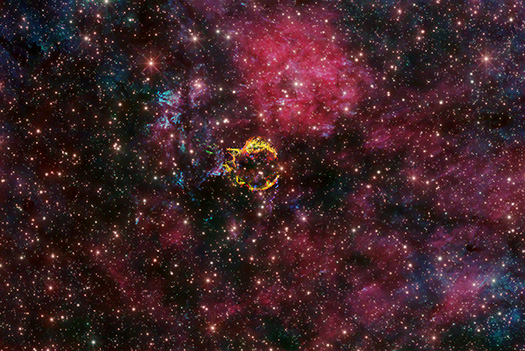
Cassiopeia A
Contributors: Tim Schaeffer, William Ostling, Justin, Adrien Keijzer, Paul Kent, BTB Astroteam Brentenriegel, Steve Gill, Tino Heuberger, Nicolas Puig, Julian Shapiro, Felix Schöfbänker, Mikhail Vasilev, David Wood
In sports, the term “pro-am” refers to a competition between professional and non-professional athletes. In astronomy, there are also “pro-am” events, but these are highly collaborative and never cutthroat.
AstroBin is an image hosting platform and social network for astrophotographers (also often known as “amateur astronomers”, though their skill and expertise should never be questioned!)
NASA Telescope Data Becomes Music You Can Play
Submitted by chandra on Wed, 2023-11-15 10:39Credit: Composition: NASA/CXC/SAO/Sophie Kastner: Data: X-ray: NASA/CXC/SAO; Optical: NASA/STScI; IR: Spitzer NASA/JPL-Caltech; Sonification: NASA/CXC/SAO/K.Arcand, SYSTEM Sounds (M. Russo, A. Santaguida); Video Credit: NASA/CXC/A. Jubett & P. David
For millennia, musicians have looked to the heavens for inspiration. Now a new collaboration is enabling actual data from NASA telescopes to be used as the basis for original music that can be played by humans.
Since 2020, the “sonification” project at NASA’s Chandra X-ray Center has translated the digital data taken by telescopes into notes and sounds. This process allows the listener to experience the data through the sense of hearing instead of seeing it as images, a more common way to present astronomical data.
A new phase of the sonification project takes the data into different territory. Working with composer Sophie Kastner, the team has developed versions of the data that can be played by musicians.
NASA Telescopes Discover Record-Breaking Black Hole
Submitted by chandra on Mon, 2023-11-06 09:08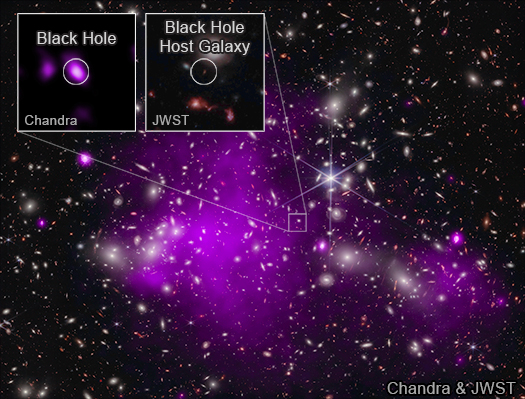
UHZ1
Credit: X-ray: NASA/CXC/SAO/Ákos Bogdán; Infrared: NASA/ESA/CSA/STScI; Image Processing: NASA/CXC/SAO/L. Frattare & K. Arcand
This image contains the most distant black hole ever detected in X-rays, a result that may explain how some of the first supermassive black holes in the universe formed. As we report in our press release, this discovery was made using X-rays from NASA’s Chandra X-ray Observatory (purple) and infrared data from NASA’s James Webb Space Telescope (red, green, blue).
The extremely distant black hole is located in the galaxy UHZ1 in the direction of the galaxy cluster Abell 2744. The galaxy cluster is about 3.5 billion light-years from Earth. Webb data, however, reveal that UHZ1 is much farther away than Abell 2744. At some 13.2 billion light-years away, UHZ1 is seen when the universe was only 3% of its current age.
X-raying the Magnetic Field Bones of the Cosmic Hand
Submitted by chandra on Fri, 2023-10-27 10:36
Roger Romani
We welcome Roger W. Romani as a guest blogger. Roger is the first author of a paper that is the subject of our latest Chandra release. He has been a professor of Physics at Stanford University for 30-odd years and helped found KIPAC, its institute focusing on astrophysics and cosmology. He is interested in high energy astrophysics problems of all sorts and likes to bring observations from multiple wavebands together with modeling to explain astrophysical puzzles. However, he has a special fondness for the extreme physics conditions associated with pulsars and their environments. Today’s blog gives one such example.
Magnetic fields are the binding agent that turn interstellar atoms into gases. Between the stars the particle density is so low that, without these fields, individual atoms would fly along like buckshot, essentially never colliding. But since the atoms are often ionized – with a positive charge because negatively charged electrons have been stripped away – their interaction with embedded magnetic fields forces them to flow in concord, resulting in the fluid-like behavior that forms many of the nebulas that enthrall us in astronomical images.
It is surprisingly hard to image this magnetic scaffolding. A new capability for magnetic mapping was introduced with the launch of NASA’s Imaging X-ray Polarimetry Explorer (IXPE) in late 2021. This telescope is sensitive to 1-10 keV X-rays and, using an ingenious photo-electron tracking camera developed by our Italian colleagues, is able to sense the polarization, or orientation of the electric field in the electromagnetic wave, of the individual X-ray events. (An “eV” is an electron volt, a unit that represents how much energy an electron gains when it is accelerated by the potential of one volt. A “keV” is 1000 eV.) So together with its imaging, timing, and energy resolution capabilities, IXPE can, for the first time, extract (albeit imperfectly) all of the information carried by each X-ray photon. The result is a color movie of the target, which also shows how the local emission is polarized.
IXPE and Chandra Untangle Theories Surrounding Historic Supernova Remnant
Submitted by chandra on Tue, 2023-10-24 10:56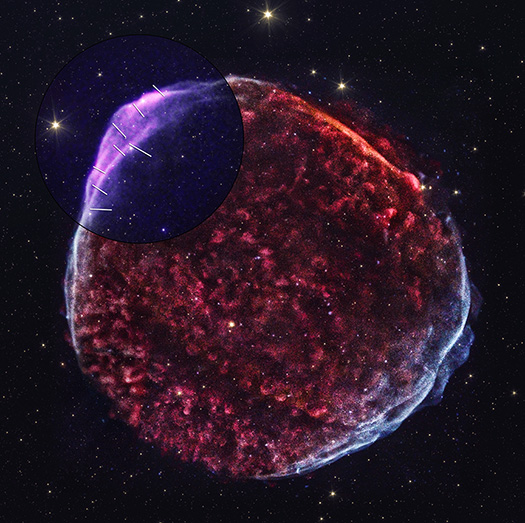
SN 1006 in X-ray and Optical Light
Credit: X-ray: NASA/CXC/SAO (Chandra); NASA/MSFC/Nanjing Univ./P. Zhou et al. (IXPE); IR: NASA/JPL/CalTech/Spitzer; Image Processing: NASA/CXC/SAO/J.Schmidt
When the object now called SN 1006 first appeared on May 1, 1006 A.D., it was far brighter than Venus and visible during the daytime for weeks. Astronomers in China, Japan, Europe, and the Arab world all documented this spectacular sight, which was later understood to have been a supernova. With the advent of the Space Age in the 1960s, scientists were able to launch instruments and detectors above Earth's atmosphere to observe the Universe in wavelengths that are blocked from the ground, including X-rays. The remains of SN 1006 was one of the faintest X-ray sources detected by the first generation of X-ray satellites.
This new image shows SN 1006 from two of NASA’s current X-ray telescopes, the Chandra X-ray Observatory and Imaging X-ray Polarimetry Explorer (IXPE). In the full image of SN 1006, red, green, and blue show low-, medium-, and high-energy detected by Chandra. The IXPE data, which measure the polarization of the X-ray light, have been added in the upper left corner of the remnant in purple. The lines in that corner represent the direction of the magnetic field.
Pages
Please note this is a moderated blog. No pornography, spam, profanity or discriminatory remarks are allowed. No personal attacks are allowed. Users should stay on topic to keep it relevant for the readers.
Read the privacy statement



